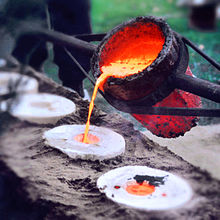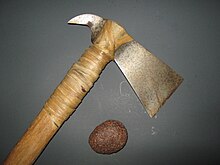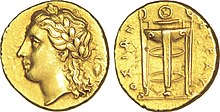An alloy is a combination of metals and of a metal or another element. Alloys are defined by a metallic bonding character. An alloy may be a solid solution of metal elements (a single phase) or a mixture of metallic phases (two or more solutions). Intermetallic compounds are alloys with a defined stoichiometry and crystal structure. Zintl phases are also sometimes considered alloys depending on bond types.
Alloys are used in a wide variety of applications. In some cases,
a combination of metals may reduce the overall cost of the material
while preserving important properties. In other cases, the combination
of metals imparts synergistic properties to the constituent metal
elements such as corrosion resistance or mechanical strength. Examples
of alloys are steel, solder, brass, pewter, duralumin, bronze and amalgams.
The alloy constituents are usually measured by mass percentage for practical applications, and in atomic fraction for basic science studies. Alloys are usually classified as substitutional or interstitial alloys,
depending on the atomic arrangement that forms the alloy. They can be
further classified as homogeneous (consisting of a single phase), or
heterogeneous (consisting of two or more phases) or intermetallic.
Introduction
Liquid bronze, being poured into molds during casting.
A brass lamp.
An alloy is a mixture of chemical elements, which forms an impure substance (admixture) that retains the characteristics of a metal.
An alloy is distinct from an impure metal in that, with an alloy, the
added elements are well controlled to produce desirable properties,
while impure metals such as wrought iron
are less controlled, but are often considered useful. Alloys are made
by mixing two or more elements, at least one of which is a metal. This
is usually called the primary metal or the base metal, and the name of
this metal may also be the name of the alloy. The other constituents may
or may not be metals but, when mixed with the molten base, they will be
soluble
and dissolve into the mixture.
The mechanical properties of alloys will often be quite different from
those of its individual constituents. A metal that is normally very soft
(malleable), such as aluminium, can be altered by alloying it with another soft metal, such as copper. Although both metals are very soft and ductile, the resulting aluminium alloy will have much greater strength. Adding a small amount of non-metallic carbon to iron trades its great ductility for the greater strength of an alloy called steel. Due to its very-high strength, but still substantial toughness, and its ability to be greatly altered by heat treatment, steel is one of the most useful and common alloys in modern use. By adding chromium to steel, its resistance to corrosion can be enhanced, creating stainless steel, while adding silicon will alter its electrical characteristics, producing silicon steel.
Like oil and water, a molten metal may not always mix with another element. For example, pure iron is almost completely insoluble with copper. Even when the constituents are soluble, each will usually have a saturation point,
beyond which no more of the constituent can be added. Iron, for
example, can hold a maximum of 6.67% carbon. Although the elements of an
alloy usually must be soluble in the liquid state, they may not always be soluble in the solid state. If the metals remain soluble when solid, the alloy forms a solid solution, becoming a homogeneous structure consisting of identical crystals, called a phase.
If as the mixture cools the constituents become insoluble, they may
separate to form two or more different types of crystals, creating a
heterogeneous microstructure
of different phases, some with more of one constituent than the other
phase has. However, in other alloys, the insoluble elements may not
separate until after crystallization occurs. If cooled very quickly,
they first crystallize as a homogeneous phase, but they are supersaturated
with the secondary constituents. As time passes, the atoms of these
supersaturated alloys can separate from the crystal lattice, becoming
more stable, and form a second phase that serve to reinforce the
crystals internally.
Some alloys, such as electrum which is an alloy consisting of silver and gold, occur naturally. Meteorites are sometimes made of naturally occurring alloys of iron and nickel, but are not native to the Earth. One of the first alloys made by humans was bronze, which is a mixture of the metals tin and copper.
Bronze was an extremely useful alloy to the ancients, because it is
much stronger and harder than either of its components. Steel was
another common alloy. However, in ancient times, it could only be
created as an accidental byproduct from the heating of iron ore in fires
(smelting) during the manufacture of iron. Other ancient alloys include pewter, brass and pig iron. In the modern age, steel can be created in many forms. Carbon steel can be made by varying only the carbon content, producing soft alloys like mild steel or hard alloys like spring steel. Alloy steels can be made by adding other elements, such as chromium, molybdenum, vanadium or nickel, resulting in alloys such as high-speed steel or tool steel. Small amounts of manganese are usually alloyed with most modern steels because of its ability to remove unwanted impurities, like phosphorus, sulfur and oxygen,
which can have detrimental effects on the alloy. However, most alloys
were not created until the 1900s, such as various aluminium, titanium, nickel, and magnesium alloys. Some modern superalloys, such as incoloy, inconel, and hastelloy, may consist of a multitude of different elements.
Terminology
A gate valve, made from Inconel.
As a noun, the term alloy is used to describe a mixture of atoms in
which the primary constituent is a metal. When used as a verb, the term
refers to the act of mixing a metal with other elements. The primary
metal is called the base, the matrix, or the solvent. The secondary constituents are often called solutes. If there is a mixture of only two types of atoms (not counting impurities) such as a copper-nickel alloy, then it is called a binary alloy. If there are three types of atoms forming the mixture, such as iron, nickel and chromium, then it is called a ternary alloy. An alloy with four constituents is a quaternary alloy, while a five-part alloy is termed a quinary alloy. Because the percentage of each constituent can be varied, with any mixture the entire range of possible variations is called a system. In this respect, all of the various forms of an alloy containing only two constituents, like iron and carbon, is called a binary system, while all of the alloy combinations possible with a ternary alloy, such as alloys of iron, carbon and chromium, is called a ternary system.
Although an alloy is technically an impure metal, when referring
to alloys, the term "impurities" usually denotes those elements which
are not desired. Such impurities are introduced from the base metals and
alloying elements, but are removed during processing. For instance,
sulfur is a common impurity in steel. Sulfur combines readily with iron
to form iron sulfide, which is very brittle, creating weak spots in the steel. Lithium, sodium and calcium are common impurities in aluminium alloys, which can have adverse effects on the structural integrity
of castings. Conversely, otherwise pure-metals that simply contain
unwanted impurities are often called "impure metals" and are not usually
referred to as alloys. Oxygen, present in the air, readily combines
with most metals to form metal oxides;
especially at higher temperatures encountered during alloying. Great
care is often taken during the alloying process to remove excess
impurities, using fluxes, chemical additives, or other methods of extractive metallurgy.
In practice, some alloys are used so predominantly with respect
to their base metals that the name of the primary constituent is also
used as the name of the alloy. For example, 14 karat gold is an alloy of gold with other elements. Similarly, the silver used in jewelry and the aluminium used as a structural building material are also alloys.
The term "alloy" is sometimes used in everyday speech as a
synonym for a particular alloy. For example, automobile wheels made of
an aluminium alloy are commonly referred to as simply "alloy wheels",
although in point of fact steels and most other metals in practical use
are also alloys. Steel is such a common alloy that many items made from
it, like wheels, barrels, or girders,
are simply referred to by the name of the item, assuming it is made of
steel. When made from other materials, they are typically specified as
such, (i.e.: "bronze wheel", "plastic barrel", or "wood girder").
Theory
Alloying a
metal is done by combining it with one or more other elements. The most
common and oldest alloying process is performed by heating the base
metal beyond its melting point
and then dissolving the solutes into the molten liquid, which may be
possible even if the melting point of the solute is far greater than
that of the base. However, some metals and solutes, such as iron and
carbon, have very high melting-points and were impossible for ancient
people to melt. Thus, alloying may also be performed with one or more
constituents in a gaseous state, such as found in a blast furnace to make pig iron, nitriding, carbonitriding or other forms of case hardening, or the cementation process used to make blister steel. It may also be done with one, more, or all of the constituents in the solid state, such as found in ancient methods of pattern welding, shear steel, or crucible steel production, mixing the elements via solid-state diffusion.
By adding another element to a metal, differences in the size of
the atoms create internal stresses in the lattice of the metallic
crystals; stresses that often enhance its properties. For example, the
combination of carbon with iron produces steel, which is stronger than iron, its primary element. The electrical and thermal conductivity of alloys is usually lower than that of the pure metals. The physical properties, such as density, reactivity, Young's modulus of an alloy may not differ greatly from those of its base element, but engineering properties such as tensile strength, ductility, and shear strength may be substantially different from those of the constituent materials. This is sometimes a result of the sizes of the atoms
in the alloy, because larger atoms exert a compressive force on
neighboring atoms, and smaller atoms exert a tensile force on their
neighbors, helping the alloy resist deformation. Sometimes alloys may
exhibit marked differences in behavior even when small amounts of one
element are present. For example, impurities in semiconducting ferromagnetic alloys lead to different properties, as first predicted by White, Hogan, Suhl, Tian Abrie and Nakamura.
Some alloys are made by melting and mixing two or more metals. Bronze, an alloy of copper and tin, was the first alloy discovered, during the prehistoric period now known as the Bronze Age.
It was harder than pure copper and originally used to make tools and
weapons, but was later superseded by metals and alloys with better
properties. In later times bronze has been used for ornaments, bells, statues, and bearings. Brass is an alloy made from copper and zinc.
Unlike pure metals, most alloys do not have a single melting point, but a melting range during which the material is a mixture of solid and liquid phases (a slush). The temperature at which melting begins is called the solidus, and the temperature when melting is just complete is called the liquidus. For many alloys there is a particular alloy proportion (in some cases more than one), called either a eutectic
mixture or a peritectic composition, which gives the alloy a unique and
low melting point, and no liquid/solid slush transition.
Heat-treatable alloys
Allotropes of iron, (alpha iron and gamma iron) showing the differences in atomic arrangement.
Photomicrographs of steel. Top photo: Annealed (slowly cooled) steel forms a heterogeneous, lamellar microstructure called pearlite, consisting of the phases cementite (light) and ferrite (dark). Bottom photo: Quenched (quickly cooled) steel forms a single phase called martensite, in which the carbon remains trapped within the crystals, creating internal stresses.
Alloying elements are added to a base metal, to induce hardness, toughness, ductility, or other desired properties. Most metals and alloys can be work hardened by creating defects in their crystal structure. These defects are created during plastic deformation by hammering, bending, extruding, etcetera, and are permanent unless the metal is recrystallized. Otherwise, some alloys can also have their properties altered by heat treatment. Nearly all metals can be softened by annealing,
which recrystallizes the alloy and repairs the defects, but not as many
can be hardened by controlled heating and cooling. Many alloys of aluminium, copper, magnesium, titanium, and nickel can be strengthened to some degree by some method of heat treatment, but few respond to this to the same degree as does steel.
The base metal iron of the iron-carbon alloy known as steel, undergoes a change in the arrangement (allotropy)
of the atoms of its crystal matrix at a certain temperature (usually
between 1,500 °F (820 °C) and 1,600 °F (870 °C), depending on carbon
content). This allows the smaller carbon atoms to enter the interstices
of the iron crystal. When this diffusion happens, the carbon atoms are said to be in solution in the iron, forming a particular single, homogeneous, crystalline phase called austenite.
If the steel is cooled slowly, the carbon can diffuse out of the iron
and it will gradually revert to its low temperature allotrope. During
slow cooling, the carbon atoms will no longer be as soluble with the iron, and will be forced to precipitate out of solution, nucleating into a more concentrated form of iron carbide (Fe3C)
in the spaces between the pure iron crystals. The steel then becomes
heterogeneous, as it is formed of two phases, the iron-carbon phase
called cementite (or carbide), and pure iron ferrite.
Such a heat treatment produces a steel that is rather soft. If the
steel is cooled quickly, however, the carbon atoms will not have time to
diffuse and precipitate out as carbide, but will be trapped within the
iron crystals. When rapidly cooled, a diffusionless (martensite) transformation
occurs, in which the carbon atoms become trapped in solution. This
causes the iron crystals to deform as the crystal structure tries to
change to its low temperature state, leaving those crystals very hard
but much less ductile (more brittle).
While the high strength of steel results when diffusion and
precipitation is prevented (forming martinsite), most heat-treatable
alloys are precipitation hardening
alloys, that depend on the diffusion of alloying elements to achieve
their strength. When heated to form a solution and then cooled quickly,
these alloys become much softer than normal, during the diffusionless
transformation, but then harden as they age. The solutes in these alloys
will precipitate over time, forming intermetallic
phases, which are difficult to discern from the base metal. Unlike
steel, in which the solid solution separates into different crystal
phases (carbide and ferrite), precipitation hardening alloys form
different phases within the same crystal. These intermetallic alloys
appear homogeneous in crystal structure, but tend to behave
heterogeneously, becoming hard and somewhat brittle.
Substitutional and interstitial alloys
Different atomic mechanisms of alloy formation, showing pure metal, substitutional, interstitial, and a combination of the two.
When a molten metal is mixed with another substance, there are two mechanisms that can cause an alloy to form, called atom exchange and the interstitial mechanism.
The relative size of each element in the mix plays a primary role in
determining which mechanism will occur. When the atoms are relatively
similar in size, the atom exchange method usually happens, where some of
the atoms composing the metallic crystals are substituted with atoms of
the other constituent. This is called a substitutional alloy.
Examples of substitutional alloys include bronze and brass, in which
some of the copper atoms are substituted with either tin or zinc atoms
respectively. In the case of the interstitial mechanism, one atom is
usually much smaller than the other and can not successfully substitute
for the other type of atom in the crystals of the base metal. Instead,
the smaller atoms become trapped in the spaces between the atoms of the
crystal matrix, called the interstices. This is referred to as an interstitial alloy. Steel is an example of an interstitial alloy, because the very small carbon atoms fit into interstices of the iron matrix. Stainless steel
is an example of a combination of interstitial and substitutional
alloys, because the carbon atoms fit into the interstices, but some of
the iron atoms are substituted by nickel and chromium atoms.
History and examples
Meteoric iron
A meteorite and a hatchet that was forged from meteoric iron.
The use of alloys by humans started with the use of meteoric iron, a naturally occurring alloy of nickel and iron. It is the main constituent of iron meteorites
which occasionally fall down on Earth from outer space. As no
metallurgic processes were used to separate iron from nickel, the alloy
was used as it was.
Meteoric iron could be forged from a red heat to make objects such as
tools, weapons, and nails. In many cultures it was shaped by cold
hammering into knives and arrowheads. They were often used as anvils.
Meteoric iron was very rare and valuable, and difficult for ancient
people to work.
Bronze and brass
Bronze axe 1100 BC
Bronze doorknocker
Iron is usually found as iron ore on Earth, except for one deposit of native iron in Greenland, which was used by the Inuit people. Native copper, however, was found worldwide, along with silver, gold, and platinum,
which were also used to make tools, jewelry, and other objects since
Neolithic times. Copper was the hardest of these metals, and the most
widely distributed. It became one of the most important metals to the
ancients. Eventually, humans learned to smelt metals such as copper and tin from ore, and, around 2500 BC, began alloying the two metals to form bronze,
which was much harder than its ingredients. Tin was rare, however,
being found mostly in Great Britain. In the Middle East, people began
alloying copper with zinc to form brass. Ancient civilizations took into account the mixture and the various properties it produced, such as hardness, toughness and melting point, under various conditions of temperature and work hardening, developing much of the information contained in modern alloy phase diagrams. For example, arrowheads from the Chinese Qin dynasty
(around 200 BC) were often constructed with a hard bronze-head, but a
softer bronze-tang, combining the alloys to prevent both dulling and
breaking during use.
Amalgams
Mercury has been smelted from cinnabar for thousands of years. Mercury dissolves many metals, such as gold, silver, and tin, to form amalgams (an alloy in a soft paste or liquid form at ambient temperature). Amalgams have been used since 200 BC in China for gilding objects such as armor and mirrors
with precious metals. The ancient Romans often used mercury-tin
amalgams for gilding their armor. The amalgam was applied as a paste and
then heated until the mercury vaporized, leaving the gold, silver, or
tin behind. Mercury was often used in mining, to extract precious metals like gold and silver from their ores.
Precious-metal alloys
Electrum, a natural alloy of silver and gold, was often used for making coins.
Many ancient civilizations alloyed metals for purely aesthetic purposes. In ancient Egypt and Mycenae,
gold was often alloyed with copper to produce red-gold, or iron to
produce a bright burgundy-gold. Gold was often found alloyed with silver
or other metals to produce various types of colored gold. These metals were also used to strengthen each other, for more practical purposes. Copper was often added to silver to make sterling silver,
increasing its strength for use in dishes, silverware, and other
practical items. Quite often, precious metals were alloyed with less
valuable substances as a means to deceive buyers. Around 250 BC, Archimedes was commissioned by the King of Syracuse
to find a way to check the purity of the gold in a crown, leading to
the famous bath-house shouting of "Eureka!" upon the discovery of Archimedes' principle.
Pewter
The term pewter
covers a variety of alloys consisting primarily of tin. As a pure
metal, tin is much too soft to be used for any practical purpose.
However, during the Bronze Age,
tin was a rare metal in many parts of Europe and the Mediterranean; due
to this it was often valued higher than gold. To make jewellery,
cutlery, or other objects from tin, it was usually alloyed with other
metals to increase its strength and hardness. These metals were
typically lead, antimony, bismuth
or copper. These solutes were sometimes added individually in varying
amounts, or added together, making a wide variety of objects, ranging
from practical items such as dishes, surgical tools, candlesticks or
funnels, to decorative items like ear rings and hair clips.
The earliest examples of pewter come from ancient Egypt, around
1450 BC. The use of pewter was widespread across Europe, from France to
Norway and Britain (where most of the ancient tin was mined) to the Near
East.
The alloy was also used in China and the Far East, arriving in Japan
around 800 AD, where it was used for making objects like ceremonial
vessels, tea canisters, or chalices used in shinto shrines.
Steel and pig iron
Puddling
in China, circa 1637. Opposite to most alloying processes, liquid
pig-iron is poured from a blast furnace into a container and stirred to
remove carbon, which diffuses into the air forming carbon dioxide,
leaving behind a mild steel to wrought iron.
The first known smelting of iron began in Anatolia, around 1800 BC. Called the bloomery process, it produced very soft but ductile wrought iron. By 800 BC, iron-making technology had spread to Europe, arriving in Japan around 700 AD. Pig iron, a very hard but brittle alloy of iron and carbon, was being produced in China
as early as 1200 BC, but did not arrive in Europe until the Middle
Ages. Pig iron has a lower melting point than iron, and was used for
making cast-iron. However, these metals found little practical use until the introduction of crucible steel around 300 BC. These steels were of poor quality, and the introduction of pattern welding,
around the 1st century AD, sought to balance the extreme properties of
the alloys by laminating them, to create a tougher metal. Around 700 AD,
the Japanese began folding bloomery-steel and cast-iron in alternating
layers to increase the strength of their swords, using clay fluxes to
remove slag and impurities. This method of Japanese swordsmithing produced one of the purest steel-alloys of the early Middle Ages.
While the use of iron started to become more widespread around
1200 BC, mainly because of interruptions in the trade routes for tin,
the metal was much softer than bronze. However, very small amounts of steel,
(an alloy of iron and around 1% carbon), was always a byproduct of the
bloomery process. The ability to modify the hardness of steel by heat treatment
had been known since 1100 BC, and the rare material was valued for the
manufacture of tools and weapons. Because the ancients could not produce
temperatures high enough to melt iron fully, the production of steel in
decent quantities did not occur until the introduction of blister steel
during the Middle Ages. This method introduced carbon by heating
wrought iron in charcoal for long periods of time, but the penetration
of carbon was not very deep, so the alloy was not homogeneous. In 1740, Benjamin Huntsman
began melting blister steel in a crucible to even out the carbon
content, creating the first process for the mass production of tool steel. Huntsman's process was used for manufacturing tool steel until the early 1900s.
With the introduction of the blast furnace to Europe in the Middle Ages, pig iron
was able to be produced in much higher volumes than wrought iron.
Because pig iron could be melted, people began to develop processes of
reducing the carbon in the liquid pig iron to create steel. Puddling
had been used in China since the first century, and was introduced in
Europe during the 1700s, where molten pig iron was stirred while exposed
to the air, to remove the carbon by oxidation. In 1858, Sir Henry Bessemer developed a process of steel-making by blowing hot air through liquid pig iron to reduce the carbon content. The Bessemer process was able to produce the first large scale manufacture of steel.
Alloy steels
Although steel is an alloy of iron and carbon, the term "alloy steel" usually only refers to those steels which contain other elements like vanadium, molybdenum, or cobalt
in amounts sufficient to alter the properties of the base steel. Since
ancient times when steel was used primarily for tools and weapons, the
methods of producing and working the metal were often closely guarded
secrets. Even long after the Age of reason,
the steel industry was very competitive and manufacturers went through
great lengths to keep their processes confidential, resisting any
attempts to scientifically analyze the material for fear it would reveal
their methods. For example, the people of Sheffield, a center of steel production in England, were known to routinely bar visitors and tourists from entering town to deter industrial espionage.
Thus, almost no metallurgical information existed about steel until
1860. Because of this lack of understanding, steel was not generally
considered an alloy until the decades between 1930 and 1970 (primarily
due to the work of scientists like William Chandler Roberts-Austen, Adolph Martens, and Edgar Bain), so "alloy steel" became the popular term for ternary and quaternary steel-alloys.
After Benjamin Huntsman developed his crucible steel in 1740, he began experimenting with the addition of elements like manganese (in the form of a high-manganese pig-iron called spiegeleisen),
which helped remove impurities such as phosphorus and oxygen; a process
adopted by Bessemer and still used in modern steels (albeit in
concentrations low enough to still be considered carbon steel). Afterward, many people began experimenting with various alloys of steel without much success. However, in 1882, Robert Hadfield, being a pioneer in steel metallurgy, took an interest and produced a steel alloy containing around 12% manganese. Called mangalloy, it exhibited extreme hardness and toughness, becoming the first commercially viable alloy-steel. Afterward, he created silicon steel, launching the search for other possible alloys of steel.
Robert Forester Mushet found that by adding tungsten
to steel it could produce a very hard edge that would resist losing its
hardness at high temperatures. "R. Mushet's special steel" (RMS) became
the first high-speed steel. In 1912, the Krupp Ironworks in Germany developed a rust-resistant steel by adding 21% chromium and 7% nickel, producing the first stainless steel.
Precipitation-hardening alloys
In 1906, precipitation hardening alloys were discovered by Alfred Wilm. Precipitation hardening alloys, such as certain alloys of aluminium, titanium, and copper, are heat-treatable alloys that soften when quenched (cooled quickly), and then harden over time. After quenching a ternary alloy of aluminium, copper, and magnesium,
Wilm discovered that the alloy increased in hardness when left to age
at room temperature. Although an explanation for the phenomenon was not
provided until 1919, duralumin
was one of the first "age hardening" alloys to be used, and was soon
followed by many others. Because they often exhibit a combination of
high strength and low weight, these alloys became widely used in many
forms of industry, including the construction of modern aircraft.












